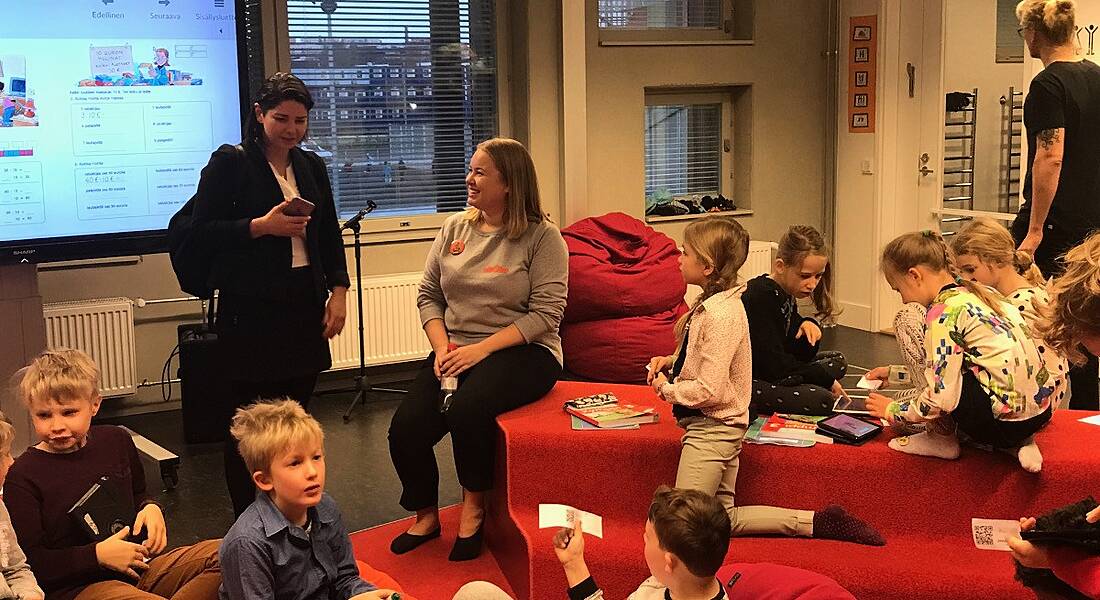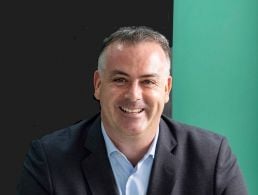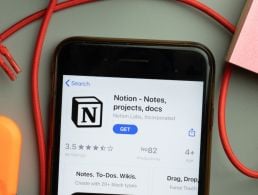What is the secret to the success of the Finnish education system? John Kennedy discovers that the answer lies in diversity, inclusion and equality.
During my recent foray to Slush in Helsinki, I got a chance to visit Kalasatama, a city-centre elementary school nestled in the Finnish capital’s harbour area.
Having read so much about how Finland revolutionised its education system to reach the pinnacle of global PISA and OECD league tables, I was determined not to gawp as Michael Moore had done in his brilliant movie Where to Invade Next when he heard about no standardised testing, no homework, the respectable standing of teachers in their local communities and the unwavering belief that all children should have a childhood.
‘Our attitude is that every place is a place to learn’
– MARJANNA MANNINEN
But yes, I was transfixed by the warm environment, hot lunches, beanbags, no desks and the existence of reading dogs (I’ll get to that later). I didn’t want to be a party pooper by recalling my own school days of prefabs, uniforms, packed lunches and by-rote learning. The only familiar comparison with my early school days was the kids’ art everywhere and the big squeezable paint tubes. May there always be paint!
Kalasatama is a brand new school that opened a year ago and is currently attended by 120 pupils. By 2020, the school will grow to 750 pupils. Ultimately, at capacity, it will be the one place kids will go to from pre-school right up to 15.
Inside, no one wears shoes on their feet, just their socks.
“The idea is, the building we are in will grow with the children and the area,” said school principal Marjanna Manninen (@MarjaanaM2). It shows how digitally attuned the teachers are that they insisted on giving their Twitter handles.
Vice-principal Jukka Ihalainen (@jukka_ihalainen) explained that there are currently 10 classes in the school looked after by 13 teachers and nine teaching assistants.
“It’s brand new architecture and it is designed to support a flexible learning environment,” Ihalainen explained. “The curriculum in Finland is designed so that the pupils themselves have an active role in learning. There is lots of collaboration, students working with teachers, flexible learning groups, and kids with special needs and mainstream students work together when reasonable.”
The modular school of the future
From left: Kalasatama school principal Marjanna Manninen and vice-principal Jukka Ihalainen. Image: John Kennedy
Technology is instantly visible. The modular school is described by Manninen as a smart building. There are 37 solar panels on the roof and every room is visible from the next with big windows everywhere. “The idea is the children will learn how to use technology as they themselves grow,” she said.
‘For kids who are learning how to read, they can read to the school reading dog. The dog won’t judge you and will always listen’
– JUKKA IHALAINEN
“Pupils do not have their own classrooms, or desks or tables. There are spaces for individual work, beanbags to sit on, and everything is flexible and light and easy to move around.
“We don’t believe kids will learn better at a desk or a table. They will learn 20 times better on beanbags, depending on what they are doing. Sometimes you need a desk and a chair, but sometimes a beanbag is easier. Kids with special needs can choose their own spaces and all our teachers plan their lessons together.”
Manninen said the core principle is that kids encounter learning everywhere. “The whole of Helsinki is the classroom. We have the park, the city centre, the zoo – it’s ideal for this kind of approach,” she said.
Ihalainen added that peer-to-peer learning is a vital factor in the education journey. “Learning groups are designed to be flexible. Teachers collaborate together to create great lessons.”
Diversity is a key factor in any city school and, in the case of Kalasatama, 50pc of current students have multicultural backgrounds.
“The open spaces and windows allow children and adults to see each other. Culturally, it helps learning when you see pupils and adults working and communicating together,” Manninen said.
So, what about computers? Having seen so many failed school IT strategies in Ireland and the UK, where iPads to PCs on every desk were promised but never delivered, the Finns have a different idea.
As I watch kids learn science through video game technology projected onto walls, Ihalainen explains: “Everyone has mobile phones and, where reasonable and useful, we will use PCs and tablets. We have very good technology in this building so pupils don’t have to bring their own technology. They can bring them in but we don’t necessarily use them. We are open to trying all kinds of games and devices.”
And, in what might appear to be anathema to lovers of structure, there are no set timetables. “We don’t have specific hours. It depends on the grade,” said Manninen. “We realise that kids spend the whole day inside the school. So, every time, when reasonable, we try to bring the kids outside the school to learn in the real world.
“In Finnish schools, there are lots of breaks and recess. For Finnish people, that is normal and rational.”
A journalist accompanying us pipped up that in New York, some schools only get five minutes’ break in the entire day.
Ihalainen looks slightly horrified and reasons: “We take many things for granted here and we realise that this is not normal elsewhere – it’s good to have perspective. For us, we believe it is important that kids can run out and play in the rain. We believe that makes it easier for them to concentrate and to learn. We also believe it is important that parents at all times can see what is happening in the schools; we make it easier to cooperate with the parents by making everything visible to them.
So, what are the Finns doing differently? There is a kind of fearlessness when it comes to trying new things that is not reflected in other countries where a conservative loyalty to longstanding curricular tradition gets in the way of progress. Fear will always hold you back.
“The school is much more than technology,” Ihalainen points out, bringing up a picture of the school reading dog. Yes, there is a school reading dog.
“Kids struggling with reading have reservations about reading to the class, and we found that for kids who are learning how to read, they can read to the school reading dog.
“The dog won’t judge you and will always listen.”
In most countries, a community school has walls and gates. The difference with Kalasatama is that it engages with its community, embracing young and old alike.
“Groups of kids visit the senior citizens in the nearby senior home and sing songs to them, and we have events here where the seniors are invited in. In Finland, different ages are mixed.”
It isn’t just Finland’s education system that is flying high. The country’s prowess at video game technology – think Rovio and Angry Birds as well as Supercell and Clash of Clans – is fuelling an entire edtech industry.
Lightneer’s Peter Vesterbacka, the former brand ambassador and ‘Mighty Eagle’ of Angry Birds developer Rovio, explained that there are about 300 start-ups in Finland focused on education technology.
Founded by former Rovio alumni including Vesterbacka, Lightneer is on a mission to create the best science-learning game on the planet. The Big Bang Legends game has been created in cahoots with some fine minds at Oxford and CERN. Lightneer recently raised $5m in a funding round led by GSV Acceleration along with IPR.VC, Brighteye Ventures and Reach Capital.
“After the Angry Birds movie went to No 1, I decided it was a good time to work on bigger things. What can be bigger than Angry Birds, a student project that began in 2003 and that is today recognised by nine out of 10 people on the planet? Education.”
Vesterbacka points out that education is a $6.3trn market and the second-biggest market in the world after food. “Finland is the only non-Asian country in the league tables that is competing with Singapore, Japan and Korea.
“Part of the reason for Finland’s success at education is our short school days, not a lot of homework, and kids have life outside of school. But, in Singapore, the school day starts at 6am and goes on until evening, and parents spend a fortune on tutoring because it is so competitive. In some cases, parents do the homework for the kids. They have to, otherwise the kids won’t get to the next level.
“What’s wrong with you people?” Vesterbacka questioned. “Kids are people too, and they have human rights. Here, we take a relaxed and casual approach and still achieve top results.”
Former Rovio ‘Mighty Eagle’ and co-founder of Lightneer, Peter Vesterbacka (in red hoodie), and Lightneer chief creative officer and former lead game designer of ‘Angry Birds’, Lauri Konttori (green). Image: John Kennedy
‘Kids are people too, and they have human rights. Here, we take a relaxed and casual approach and still achieve top results’
– PETER VESTERBACKA
He said that if Finnish edutech start-ups are on a mission to capture up to $300bn – a sliver of the global education market – that would still be an enormous success for the country.
At Kalasatana, kids play Lightneer’s Big Bang Legends on tablets and PCs. “The idea is that they can have a lot of fun playing but they are learning particle physics without realising it. All of the characters in the game are from the periodic table of elements. We already have kids in Finnish schools who are fans of Copper, Helium and Neon. All the kids who play the game know that Neon consists of 10 protons. All the elements and atoms are turned into characters and the kids know all the elements because they play the game.”
21st-century learning skills
I also talked to Kirsi Haapamäki from Mightifier, a popular app that focuses on using game techniques to help kids in schools develop mentally and emotionally.
‘We try to teach kids the ability to have trusting human relationships and improve their wellbeing and social skills’
– KIRSI HAAPAMÄKI
“The world is changing at a huge pace, faster than ever before, and students in schools will end up doing jobs we don’t even know about yet. Education is about preparing them to answer questions we don’t have yet for a world we don’t even know yet. That means we have to prepare them for a world they will need to survive in and find their own answers.
“PISA and OECD are concerned about 21st-century skills. Wellbeing data from around the world highlights that the two main threats to student wellbeing and the ability to learn are anxiety and bullying. If you feel anxious, how could you be expected to learn? The same is true for adults at work.”
Teachers and children alike use the Mastifier app, and the kids are encouraged to say something positive about their colleagues.
Haapamäki points out that regular ‘mightifying’ leads to an improved class environment, less bullying and a better focus on learning, adding that it could have applications in the adult working world down the line.
“We try to teach kids the ability to have trusting human relationships and improve their wellbeing and social skills. Mightifier teaches children how to give each other positive feedback based on their character strengths. Positive psychology is the science that makes everything worth living for by focusing on positive things, feeling positive things and, in doing so, boosting self-esteem [and] reducing anxiety and bullying.”
As Haapamäki talks, kids assess each other using Mightifier, focusing on 27 character strengths, including creativity, leadership, kindness and persistence. “Everybody has these character strengths, we just learn to use them differently. But, if you are aware of your strengths, you can impact the world around you and it also boosts your problem-solving abilities.”
So, what is Finland’s secret sauce for learning?
The secret to Finland’s surge in the education ranks is a certain fearlessness and willingness to try something new. It is also about remembering that kids are humans too, and deserve to enjoy their childhoods.
But what was also evident during my visit to Helsinki was the pride each community has in its school. Education is respected and appreciated, and so are the educators.
“As a parent, you don’t worry about where you live. Every school in Finland is equal. It’s not like you have to wonder where in the city you should live in order for your child to receive a good education. All schools are the same and equal. That’s the reason for the success of Finland’s education system,” said Manninen.
This principle carries through from newly arrived immigrants to kids with special needs, and it is all designed to help them fit in and thrive. “There are no social divisions when it comes to education. That’s the key to Finnish success. Where you live doesn’t matter.”
And, even despite its success in turning its education system around from one of failure to one that towers globally, Finland is hoping to do more with an even newer curriculum.
The bravery and openness to new ways of doing things would astonish the most slavish followers of rules and by-rote learning in education systems around the world. For example, the new curriculum contains recommendations – not orders – to phase out numerical grades for assessing student performance in favour of more qualitative approaches such as written and spoken feedback.
Manninen sums it up: “It is all about changing learning environments to be more learning-centric. You don’t need so many desks and chairs; you can be innovative. The curriculum encourages schools to get outside their buildings. For example, there is a huge library here in Helsinki’s city centre and lots of places to visit during the school day.
“Our attitude is that every place is a place to learn.”




